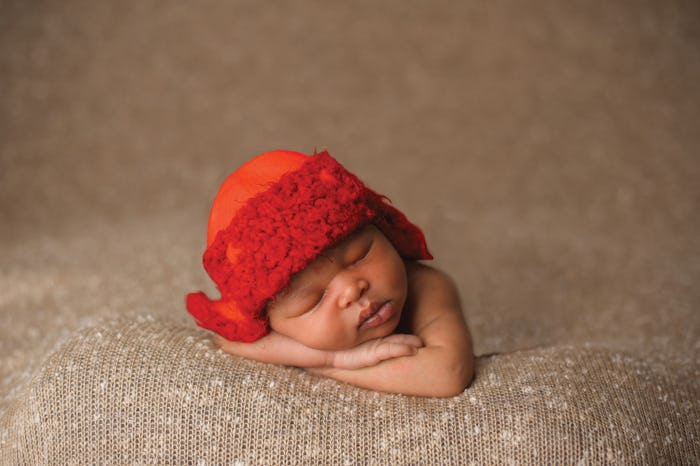Life
Knitters, This Organization Needs Your Help Knitting Tiny Red Hats For Newborns
Do you love to crochet or knit? Do you love babies? Do you love to crochet clothes for babies? If you answered yes to all of these questions, then this may be the perfect opportunity for you. Earlier this week, the American Heart Association announced it's looking for volunteers to knit red hats for babies to help spread awareness about congenital heart defects (CHD) and heart disease.
The push for volunteer knitters and crocheters is part of the American Heart Association's Little Hats, Big Hearts campaign celebrating American Heart Month this February. According to TODAY, the organization plans to distribute the tiny red hats to thousands of newborns born in February not only to educate families on congenital heart defects, but to also provide resources and inspire heart-healthy lifestyles through diet and exercise.
The American Heart Association, which teamed up with The Children's Heart Foundation, will hand out the knitted caps to February babies in hospitals across more than 40 states. In one recent year, the Little Hats, Big Hearts program drew hundreds of volunteers who created 90,000 accessories, according to TODAY. That is more than 300 times the number of tiny hats designed by knitters when the campaign first launched three years ago in Chicago.
Congenital heart defects affect about 40,000 — or 1 percent — of infants born in the United States each year, according to the U.S. Centers for Disease Control and Prevention. The CDC estimated that about 25 percent of those babies born with CHD have a complex or critical version of the birth defect, and would, in general, need surgery within the first year of life.
Congenital heart defects are also among the leading causes of birth defect-related illness and death, according to a study published in the journal Clinical and Molecular Teratology. CHDs impacts a baby's heart's structure, and can affect the interior walls and valves, as well as the arteries and veins that allow blood to flow to the heart or the body, according to the National Heart, Lung, and Blood Institute. Some types of congenital heart defects may have no symptoms, while others may be life-threatening.
The exact number of children and adults living with heart defects is unknown because, as the CDC pointed out, there is no system tracking the growing population of older kids and adults with CHD. But, according to a 2010 study published in the AHA journal Circulation, more than two million babies, children, youth, and adults in the United States were living with congenital heart defects.
The prevalence of congenital heart defects is increasing, according to the CDC, which makes programs like Little Hats, Big Hearts even more crucial. Raising awareness about what causes CHD and what is necessary to maintain proper treatment and care is important to ensuring a baby born with a heart defect lives a full, healthy life.
Knitting and crocheting enthusiasts who are interested in volunteering can visit the Little Hats, Big Hearts website for more details. Each participating city and state has different locations and deadlines, so would-be volunteers would need to contact a local office for more information. The program's website also has links to sample patterns for volunteers to reference, like this adorable baby bear hat from Fiber Flux. The hats, though, should be red and made from medium to heavy weight acyrlic or cotton yarn, and should be free of buttons or small objects that could fall off and hurt the baby. The American Heart Association also requests the caps be machine washable and dryable.
The American Heart Association is also accept donations of yarn. So if you can't knit or crochet, consider donating tons and tons of soft cotton or acrylic threads. Because there's no one way to show you have a big heart.
Check out Romper's new video series, Romper's Doula Diaries:
Watch full episodes of Romper's Doula Diaries on Facebook Watch.
